Garmin nuvi 2699LMT-D Review
Garmin nuvi 2699LMT-D
Combines a huge screen with lifetime traffic and map updates, at a bargain price
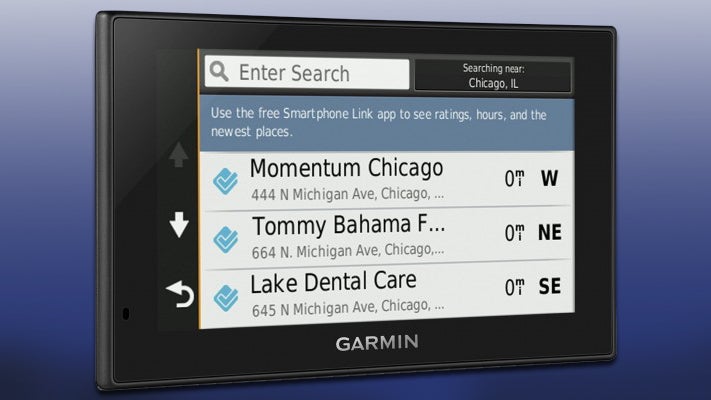
Verdict
Pros
- Lifetime European map updates and Digital Traffic
- Great voice control
- Large 6-inch display
Cons
- Digital Traffic not as detailed as TomTom Traffic
- Two-part screen connection procedure
Key Specifications
- Review Price: £190.27
- 6-inch screen with 800 x 480 pixels
- Maps for 45 European countries with lifetime updates
- Lifetime Digital Traffic
- Compatible with Garmin Smartphone Link
- Voice-control system
What is the Garmin nuvi 2699LMT-D?
The nuvi 2699LMT-D is the middle member in Garmin’s new Advanced Sat-Nav Series – but even though it’s not the flagship model, it’s still packing a huge 6-inch screen.
The range starts with the 5-inch 2599LMT-D, and is topped by the whopping 7-inch 2799LMT-D, making you wonder how much of your windscreen will be left to see if this escalation of sat-nav sizes continues.
Garmin nuvi 2699LMT-D – Features and Design
The 2699LMT-D is packed with features. Aside from the 6-inch screen, it comes with maps of 45 European countries, most of them in full detail, for which there are lifetime updates. Garmin’s Digital Traffic is built in, again with a subscription-free service for the lifetime of the device. There’s Bluetooth, so the sat-nav can be used for hands-free calling, but it can also link to your smartphone for other purposes. There’s voice control, too.
The main two new features are Direct Access and Foursquare Points of Interest (POIs). The former attempts to combat the frequent problems that can be encountered when you drive towards a large destination such as a music venue or shopping centre, where a sat-nav just leads you to the nearest point, when in fact the shop you want is closer to a car park on the other side.
Related: 5 Best Dash Cams right now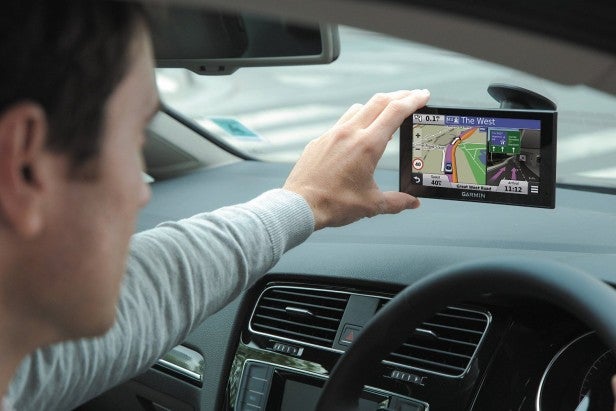
For example, when searching for the Brent Cross shopping centre, we were given choices of navigating to the Fenwicks and John Lewis sides, which are on opposite ends of the building and have car parks nearby, as well as Marks & Spencer, which is in the middle. This isn’t a huge new feature, but could be useful if you need to pick someone up after a shopping trip.
As already mentioned, there’s support for Garmin’s Smartphone Link for Android and iOS. This works in tandem with the built-in Foursquare POIs. The latter add user-generated suggestions for restaurants, shops, and so on, but with an active Smartphone Link the POIs are augmented by more detailed information, including user ratings, prices and hours of service. You can also check in via your Foursquare account, should you enjoy annoying your friends in this way.
The Smartphone Link can also be used to send destination information to the sat-nav from your phone’s contact list. Reporting safety-camera locations can be performed using the phone, and there’s a weather service built in, too. Of course, none of this should be accessed when you’re actually driving.
The 2699LMT-D comes with the usual suction windscreen mount. However, the power cable attaches separately via mini USB on the rear. So hooking up and disconnecting the device is a two-part manoeuvre, rather than the single-click operation of higher-end devices. Still, that’s the only way this sat-nav doesn’t live up to premium expectations, with a solid build and attractive, no-nonsense design.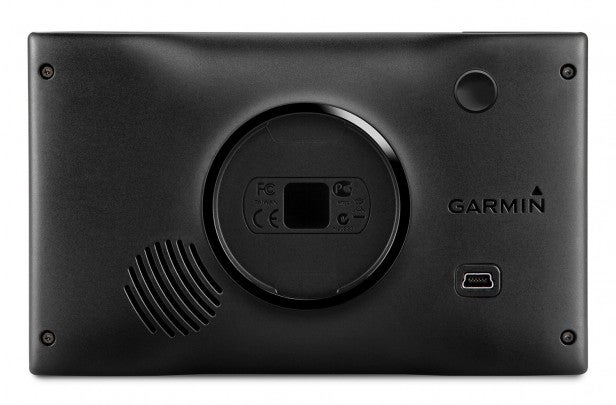
Garmin nuvi 2699LMT-D – Performance
As already mentioned, this nuvi features Garmin’s brilliant voice command system. As long as there isn’t too much background noise – so maybe turn down the car stereo – the voice command system is the most usable we’ve come across in a sat-nav, giving you the facility to enter an address or browse a points-of-interest category without touching the sat-nav at all.
SEE ALSO: Best Sat-Nav Round-up
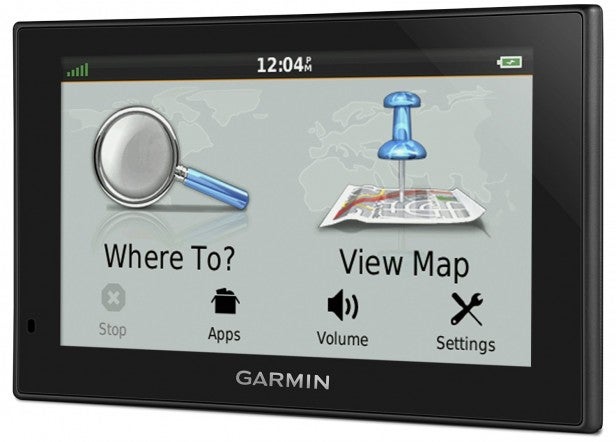
However, the voice command system doesn’t let you search for a destination by keyword. It works so well because it expects information in a fixed format, narrowing down the search options. But if you use the Where To? icon in the main menu, you can simply enter a few words by hand to search across the address, POI, and Foursquare POI databases simultaneously.
The navigational experience hasn’t changed over the last few generations of Garmin sat-navs. The top bar shows the next turning, how far away it is, and the road name or number to look out for. The map is the usual colourful presentation, with a big pink line showing your route. Key points of interest are shown on the screen, including restaurants and petrol stations, and you can select any to make a detour.
The speed limit’s shown on the bottom right, and underneath that is your current speed. On the right is your estimated arrival time, and in between is the name of the current road. It’s a clear arrangement with just the right amount of information, and the 2699LMT-D’s 800 x 480-pixel 6-inch display provides plenty of visual detail, although the glass screen is a little shiny and prone to reflections in very bright conditions.
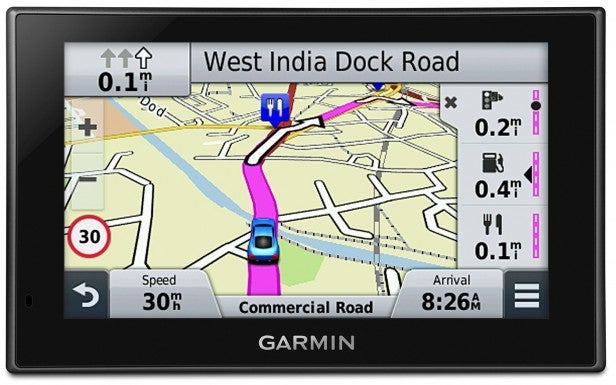
You can also call up more detailed trip data, which is shown on the right-hand side of the screen. This does clutter the interface up a little, but on a 6-inch display there’s plenty of room for the map to be fully visible. Overall, it’s a very commendable navigational experience, with timely visual directions and clear verbal instructions that use landmarks as well as street names to guide you, which Garmin is calling Real Directions.
Routing is enhanced by Garmin’s Digital Traffic, which is essentially RDS-TMC traffic delivered via a built-in DAB radio receiver, although the information is also enhanced by data from users of Garmin’s phone apps. The service isn’t as detailed as TomTom’s Traffic, but it works via the supplied car power cable, with no subscription fees, and updates every minute, so it’ll be enough to steer you clear of most major jams.
However, we noted that one of our regular criticisms of Garmin’s POIs – the continued existence of a Texaco station in the local area that was rebuilt as flats six years ago – is still appearing as a source of fuel. Garmin sorely needs a map-correction system with user input to sort little inconsistencies like this out.
Should I buy the Garmin nuvi 2699LMT-D?
Errant petrol stations aside, the Garmin nuvi 2699LMT-D is a lot of sat-nav for under £200. You’d need to shell out around £60 more for a TomTom with traffic that doesn’t require a smartphone connection, although the overall TomTom Traffic service is superior. Nevertheless, Garmin Digital Traffic is still very capable, and is just one of the many excellent features of this top-value sat-nav.
Verdict
The Garmin nuvi 2699LMT-D packs in a comprehensive set of navigational features for a great price.
Next, read more Sat-Nav Reviews
Trusted Score
Score in detail
-
Battery Life 7
-
Value 10
-
Features 9
-
Performance 9
-
Design 9
-
Usability 9
Features
| Screen Size (inches) (Inch) | 6in |
| Display Type | Color |
| General Features | Lifetime map updates for 45 European countries; lifetime Digital Traffic |
| Hands Free | Bluetooth |
Physical Specifications
| Live Services | Via Garmin Smartphone Link |
| Battery life (Hour) | 1hr |
| Height (Millimeter) | 94mm |
| Width (Millimeter) | 168mm |
| Depth (Millimeter) | 19mm |
| Weight (Gram) | 268g |


